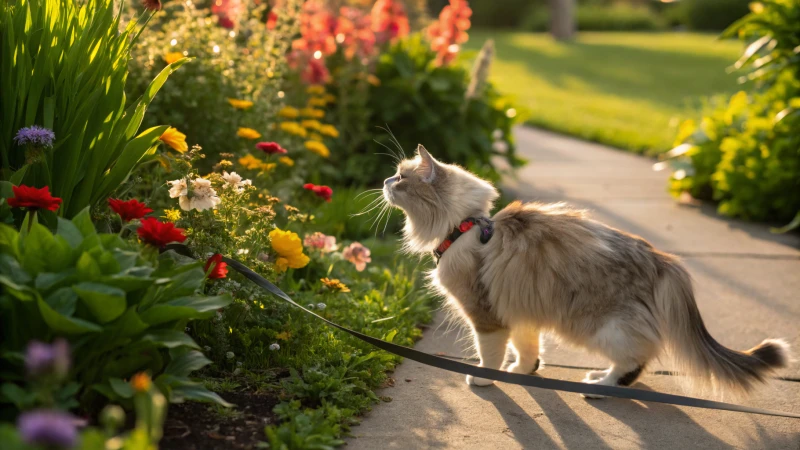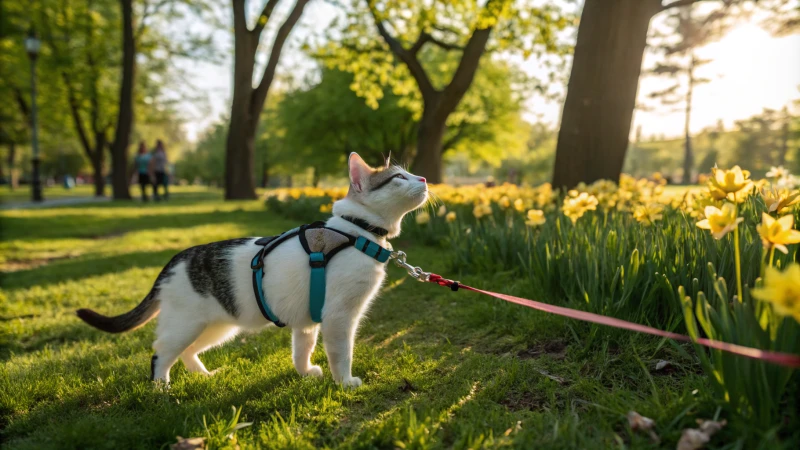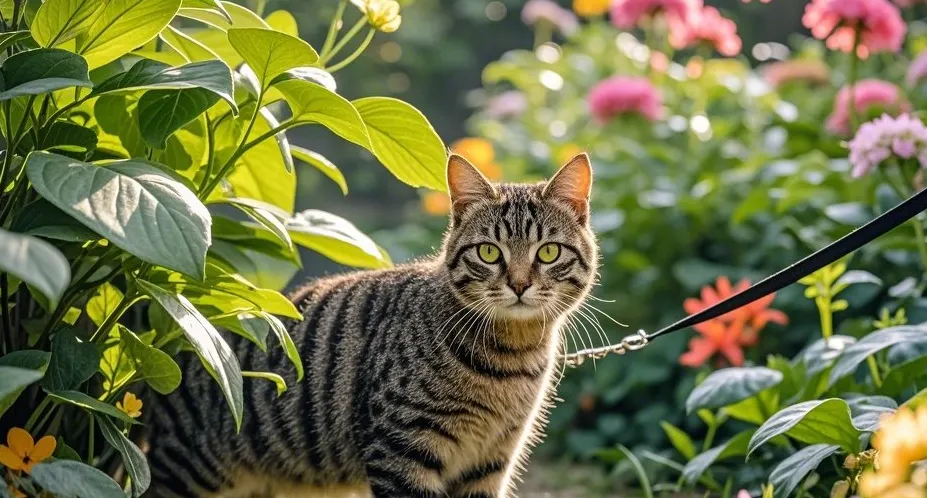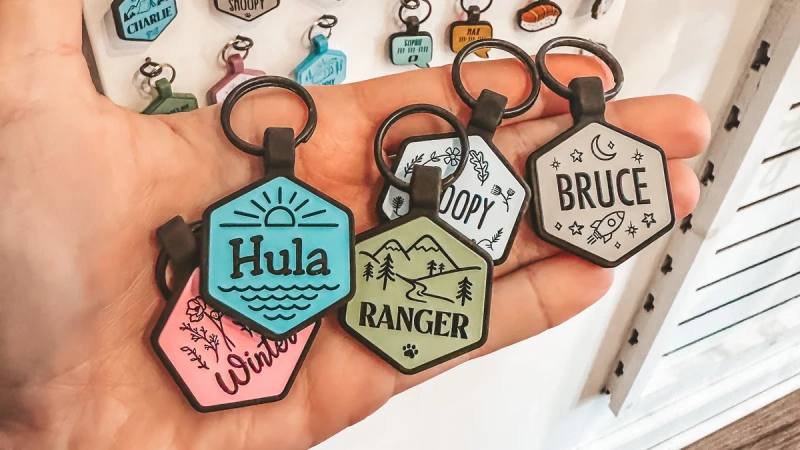
Picture turning your cat’s time outside into a thrilling journey. Walking your furry buddy on a leash offers a world full of discovery!
Cats really enjoy outdoor walks on a leash! Personalities probably differ a lot. Understand your cat’s comfort levels. Use good training techniques. You create a safe and fun outdoor adventure for both of you.
I want to tell my story about teaching my cat to walk on a leash. You might discover if this is good for your pet, too. We will look closely at the happiness of exploring outside. Useful ideas will follow to make this outing a precious time together.
Leash walking is safe for all cats.False
Not all cats are suited for leash walking; safety depends on individual temperament and training.
Training is essential for a positive leash walking experience.True
Proper training techniques are crucial to ensure that the cat enjoys the outdoor adventure safely.
What Are the Benefits of Taking Your Cat Outside on a Leash?
Have you ever considered bringing your cat outside on a leash? This idea might seem unusual. However, it can turn into an adventure for both you and your cat! Let’s explore the real benefits of this special experience together.
Walking your cat outside on a leash gives many benefits. It provides mental stimulation for your cat. Your cat enjoys physical exercise too. You also get closer to your cat during these trips. This happens while keeping your cat safe during outdoor adventures.

Taking My Furry Friend Outside on a Leash
Taking my furry friend outside on a leash is one of the best experiences. Watching her explore beyond our window is a joy. Her happiness is clear and it brightens my life too!
Mental Stimulation
The biggest benefit is the mental stimulation it provides. I remember the first time I took my cat, Bella, outside. Her little ears perked up at the sound of birds and the feel of the breeze. It was like a new playground for her! Cats are curious by nature. Taking them out opens up a world of new sights, sounds, and smells. This sensory feast is vital for keeping boredom away. Bored cats might develop behavioral problems.
To maximize mental stimulation during our walks, I change our walking paths regularly. One day we explore a quiet park; the next, we wander a small nature trail. Each trip is a new adventure that keeps her excited. If you want more ideas for your pet’s mental health, check out cat mental health resources1.
Physical Exercise
Let’s talk about physical exercise. Like many cats, Bella naps a lot when left alone. Regular leash walks have changed things; they encourage her to move more. Staying active is very important for her health. I’ve seen her become more lively and full of energy.
A table below illustrates the recommended daily activity levels for cats:
| Age Group | Recommended Daily Activity |
|---|---|
| Kittens (0-6 months) | 30-60 minutes |
| Adult Cats (1-7 years) | 20-30 minutes |
| Senior Cats (8+ years) | 15-20 minutes |
Knowing I help Bella maintain a healthy weight relaxes me and helps avoid weight-related health issues. For more tips on pet fitness, check out pet weight management2.
Bonding Experience
The best part of our outdoor adventures is bonding; it’s not just about exercise but quality time together. During walks, Bella becomes more loving and trusting. I use treats and praise to reward her, enhancing training while fostering trust and companionship.
We create our own little world out there! For tips on building a strong bond with your cat, see bonding with pets3.
Safety Considerations
Safety is very important; I learned this when I used a collar instead of a harness. Choose a harness made for cats to keep them secure and introduce outdoor experiences slowly.
I started with Bella in our backyard—a quiet space for her to get used to the outdoor sights and sounds.
A table summarizing key safety tips for outdoor leash walking includes:
| Safety Tip | Description |
|---|---|
| Use a harness instead of a collar | Collars can pose choking hazards during walks. |
| Start slow | Begin with short sessions in quiet spaces. |
| Monitor body language | Watch for signs of fear or anxiety in your cat. |
Following these safety tips allows us to enjoy many safe outdoor adventures! Thinking about taking your cat out on a leash? Try it—it might become your favorite activity!
Leash walking provides essential physical exercise for cats.True
Regular outdoor walks help prevent obesity and promote overall health in cats.
Taking cats outside on a leash enhances their mental stimulation.True
New sights and sounds outdoors keep cats engaged and reduce boredom-related issues.
How Can You Tell if Your Cat Will Enjoy Leash Walking?
Ever thought about walking your cat? It’s a lovely idea. But how do you know if your cat will like it? Let’s figure out if your kitty is ready for this outside adventure.
Identify your cat’s enjoyment of leash walking by studying their personality traits and body language. Observe if they feel curious and comfortable in new places. Slowly introduce the harness to them. Pay attention to their reactions during walks. Every cat is unique. Adjust your approach based on their behavior.

Understanding Your Cat’s Individual Preferences
Each cat has a distinct personality, just like people. I recall when I first considered taking my cat, Whiskers, out on a leash. He was watching the world outside with curiosity, tapping the glass with his tiny paws, longing to join the birds. This curiosity made me hopeful.
To determine if your cat will enjoy this experience, observe their reactions in different environments. For example, if they are naturally curious and explore new areas with enthusiasm, they may be more inclined to enjoy leash walking. Conversely, if your cat tends to hide or show signs of stress in unfamiliar surroundings, it may be best to reconsider.
Recognizing Body Language
Understanding cat body language is very important. I’ve learned to read Whiskers like a book. Here are some signs to notice:
- Tail Position: A raised tail shows confidence and happiness. A low or puffed-up tail suggests fear or anxiety.
- Ears Orientation: Forward-facing ears show curiosity, while flattened ears indicate discomfort.
- Vocalizations: Purring usually means contentment. Growling or hissing? That’s a warning.
These signs help understand your cat’s readiness for leash walking. For more on feline behavior, check out understanding feline body language4.
Gradual Introduction to the Harness
Introducing the harness slowly helps a lot. When I first showed the harness to Whiskers, he was careful but interested. Here’s a simple table to guide you through the process:
| Step | Action | Purpose |
|---|---|---|
| Choose Equipment | Select a well-fitted harness designed for cats. | Safety and comfort during walks. |
| Introduce Harness | Allow your cat to sniff and explore it before wearing it. | Create positive associations. |
| Practice Indoors | Let your cat drag the leash indoors to get used to the sensation. | Familiarity with the feeling of being leashed. |
| Start Outside | Begin in a quiet, enclosed area for initial walks. | Minimize distractions and stress. |
These steps revealed how Whiskers felt about leash walking. When he started walking happily with the harness, I knew we found something positive.
Socialization and Past Experiences
Think about your cat’s social background. Cats exposed to various experiences early tend to adapt better to new things. Whiskers was adventurous as a kitten, exploring the garden daily.
Older cats can learn new things too! If your cat has had negative experiences outside before, they might be hesitant about leash walking; patience is key here! Positive reinforcement can help build confidence over time.
For more training tips, visit cat training techniques5.
Assessing Comfort During Walks
While exploring the world on a leash, watch your cat’s comfort level continuously during walks; if they seem stressed at any point during an outing—end that session early! It’s about building confidence together!
Bringing Whiskers’ favorite treats helped a lot; he got snacks for brave steps!
Stay alert to their body language throughout each walk; every cat is unique—that’s what makes our furry friends so special!
By focusing on these elements, you’ll know if your cat enjoys leash walking! You’ll have a delightful time exploring the outdoors together!
Curious cats are more likely to enjoy leash walking.True
Cats that explore new environments with enthusiasm usually adapt well to leash walking, indicating they may enjoy the experience.
A low tail position signals a cat ready for leash walking.False
A low tail often indicates fear or anxiety in cats, suggesting they may not be comfortable with leash walking.
What Equipment Do You Need for Safe Cat Leash Walking?
Walking my cat on a leash has been a really delightful experience. This activity lets me bond with my feline friend. Before starting our adventures, I learned that the right gear is very important. What items should you pack for a fun time with your kitty?
Walking your cat on a leash needs several items. A harness that fits well is essential. A short leash is also necessary. ID tags help if your cat wanders off. Bring treats to reward your cat. A portable water bowl might be useful. These items provide comfort and security for your cat.

To safely walk your cat on a leash, a well-fitted harness, a short leash, ID tags, treats and maybe a portable water bowl are very important. Each item helps keep my furry companion safe and comfortable during our outdoor adventures.
Choosing the Right Harness
Selecting the right harness is crucial for your cat’s comfort and safety during leash walks. A properly fitted harness should distribute pressure evenly across your cat’s body and prevent escape.
| Type of Harness | Description | Pros | Cons |
|---|---|---|---|
| H-Style Harness | Resembles an ‘H’ shape, snug fit around the body. | Secure fit; good for escape-prone cats. | Can be tricky to put on. |
| Vest Harness | Covers more surface area, resembling a vest. | Comfortable; distributes pressure well. | Some may restrict movement. |
| Adjustable Harness | Offers multiple adjustment points. | Customizable fit for all body shapes. | May require more time to adjust. |
When choosing a harness, prioritize comfort and ensure it is specifically designed for cats, as collars can lead to injuries during leash walking more info6.
Selecting a Leash
The leash is another essential component of safe cat leash walking. A short leash (around 4 feet) allows for better control while keeping your cat close to you.
Leash Options:
- Standard Leash: Simple design, great for most walks.
- Retractable Leash: Allows more freedom but can lead to tangles.
Using a standard leash is generally recommended for beginners as it helps maintain focus on your cat’s behavior read more7.
Additional Equipment and Accessories
Besides the harness and leash, consider other equipment that can enhance your outdoor experience:
- Cat ID Tags: Ensure your cat has identification in case they slip out of the harness.
- Treats: Bring along treats to reward good behavior and encourage exploration.
- Portable Water Bowl: Keep your cat hydrated during longer walks.
Safety Considerations
Ensure that you are aware of your surroundings during walks. Choose quiet areas without heavy traffic or too many people to avoid overwhelming your cat. Pay attention to signs of stress in your cat, such as hiding or attempting to escape, and respond accordingly safety tips8.
With the right gear and a positive attitude, I create a safe and enjoyable environment for my cat and me. Preparation and understanding your furry friend’s needs matter a lot. Trust me, it really makes a difference!
A vest harness is the safest option for leash walking cats.True
Vest harnesses distribute pressure evenly and provide comfort, making them ideal for safe cat leash walking.
Retractable leashes are recommended for beginners walking cats.False
Standard leashes offer better control and focus, making them more suitable for novice cat walkers than retractable options.
What Are the Risks of Taking Your Cat Outside on a Leash?
I am a proud cat parent. I have often wondered about taking my indoor cat on outdoor adventures. Excitement fills me when I think about it, but understanding the risks is necessary. Let’s explore these dangers together. It’s very important.
Walking your cat outside on a leash has dangers. Traffic and predators can be threats. Parasites may cause health issues. Unfamiliar places might stress your cat. The outdoor world holds many risks. Knowing these risks is very important. Knowledge helps keep your cat safe. Your cat really deserves a safe adventure.

Understanding Outdoor Hazards
Walking my cat on a leash has always been my dream. I picture her enjoying nature, sniffing flowers and lying in the sun. But, going outdoors comes with risks. Let’s look at the dangers and how we keep our cats safe while enjoying nature.
Taking your cat outside on a leash can expose them to various hazards that may not be present indoors. Common dangers include:
-
Traffic: Busy roads near my home worry me. My cat might suddenly run into danger if startled. Even calm cats react unpredictably in new places.
-
Predators: Some places have threats from dogs or large birds that may harm cats. It’s sad to imagine them unaware of these dangers until it’s too late.
-
Toxic Plants: Nature is lovely, but some plants can harm cats. Knowing which plants are safe is crucial for a stress-free outing.
Parasites and Disease Exposure
Outdoor adventures may lead to parasites. Before leash walking, my cat gets vaccinations and treatments. This protects her. Really, it keeps her safe.
Outdoor environments can also expose your cat to:
| Parasite | Description | Health Risk |
|---|---|---|
| Fleas | Small insects that can cause itching and skin infections | Allergies, skin infections, tapeworms |
| Ticks | Arachnids that can transmit Lyme disease | Lyme disease, anaplasmosis |
| Worms | Internal parasites that can lead to serious health issues | Weight loss, vomiting, diarrhea |
It’s important to ensure your cat is up-to-date on vaccinations and parasite prevention before introducing them to the outdoors.
Stress and Anxiety
Not every cat likes the outdoors. My first try revealed surprising reactions:
- Hiding or trying to go back inside
- Loud meowing, expressing fear
- Staying low and frozen with worry
These signs clearly showed she was stressed. It’s important to understand our cats’ comfort and expose them gradually. Forcing them can increase stress. You might want to consider gradual exposure with these tips9 I discovered to ease them into adventures without fear.
Environmental Risks
Cats love exploring, even in unsafe areas:
- Water Hazards: Once, my cat got too near a pond. Water poses drowning risks—serious risks.
- Sharp Objects: Glass or metal scraps may hurt her paws. I always check for dangers before she explores.
- Extreme Weather: Hot or freezing paths harm sensitive paws; weather checks are vital before going out.
Creating a safe outdoor area is my priority; using secure enclosures10 or supervising closely keeps her safe.
Tips for Safe Leash Walking
To keep leash walking enjoyable:
- Choose Safe Locations: Quiet parks or backyards are best at first.
- Supervise Closely: Staying close prevents accidents and keeps her secure.
- Monitor Weather Conditions: I always check the weather to avoid extremes; her comfort always matters.
These steps really improve my cat’s outdoor adventures and keep her safe. Every outing becomes a special journey for us both!
Taking a cat outside on a leash can expose them to traffic hazards.True
Busy roads pose significant dangers, as startled cats may dart into traffic, risking serious injury or death.
All cats enjoy being outside on a leash without stress.False
Not all cats are comfortable outdoors; many may show signs of stress or anxiety in unfamiliar environments.
Conclusion
Discover the benefits and considerations of walking your cat on a leash, including training tips, safety measures, and understanding your cat’s unique personality for enjoyable outdoor adventures.
-
Discover how leash walking can enhance your cat’s life by exploring its benefits such as exercise and mental stimulation. ↩
-
Learn how to bond better with your cat through leash walking and create meaningful experiences together. ↩
-
Find safety tips for taking your cat outside on a leash to ensure enjoyable outings without risks. ↩
-
Explore expert advice on assessing your cat’s readiness for leash walking and ensure enjoyable outdoor experiences for both of you. ↩
-
Learn effective training techniques for introducing your cat to leash walking safely and comfortably. ↩
-
Clicking this link will provide you with essential tips on selecting the best harness for your cat’s safety and comfort. ↩
-
This link offers insights into leash types that work best for walking cats, ensuring you choose the right one for your pet. ↩
-
Explore this resource for essential safety tips while walking your cat on a leash, keeping both of you safe during outdoor adventures. ↩
-
Learn about the potential dangers of outdoor exploration for cats and how to mitigate these risks effectively. ↩
-
Discover how to create a safe environment for your cat during outdoor adventures and prevent potential hazards. ↩



